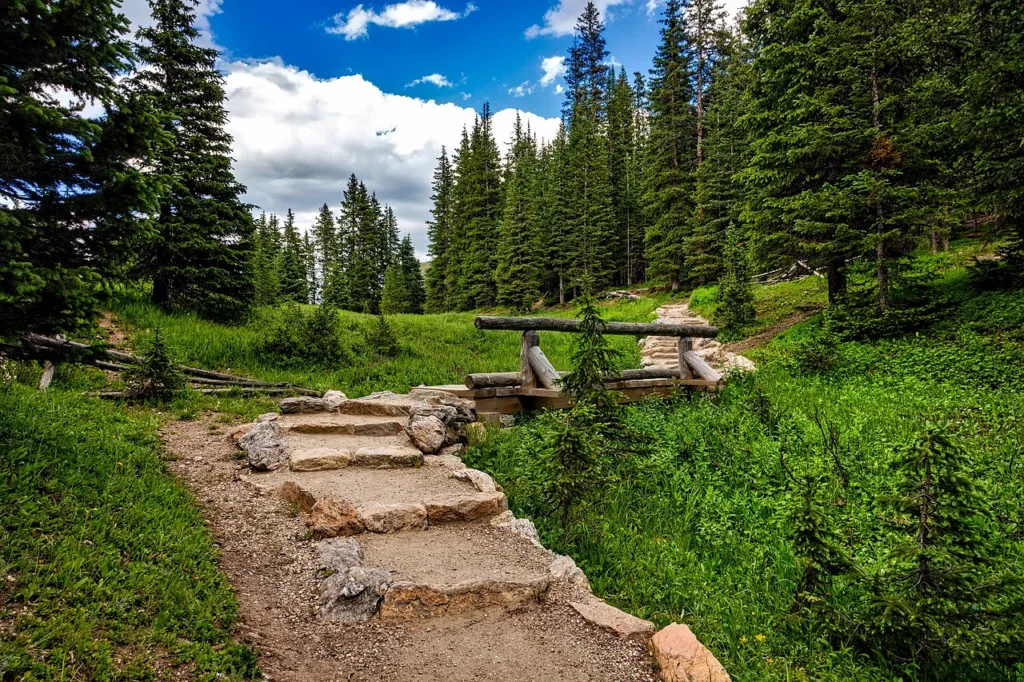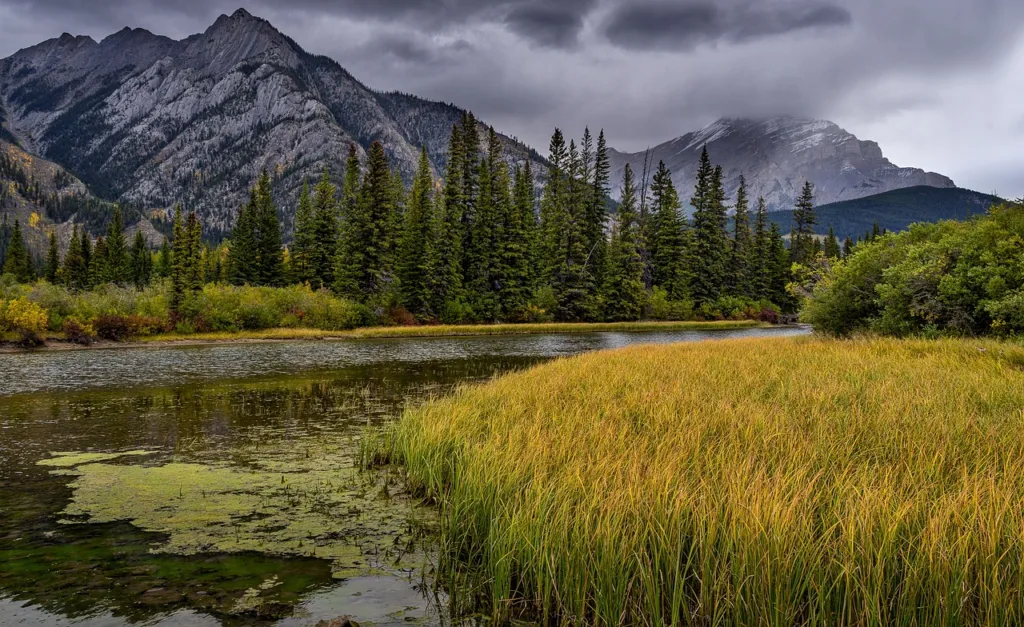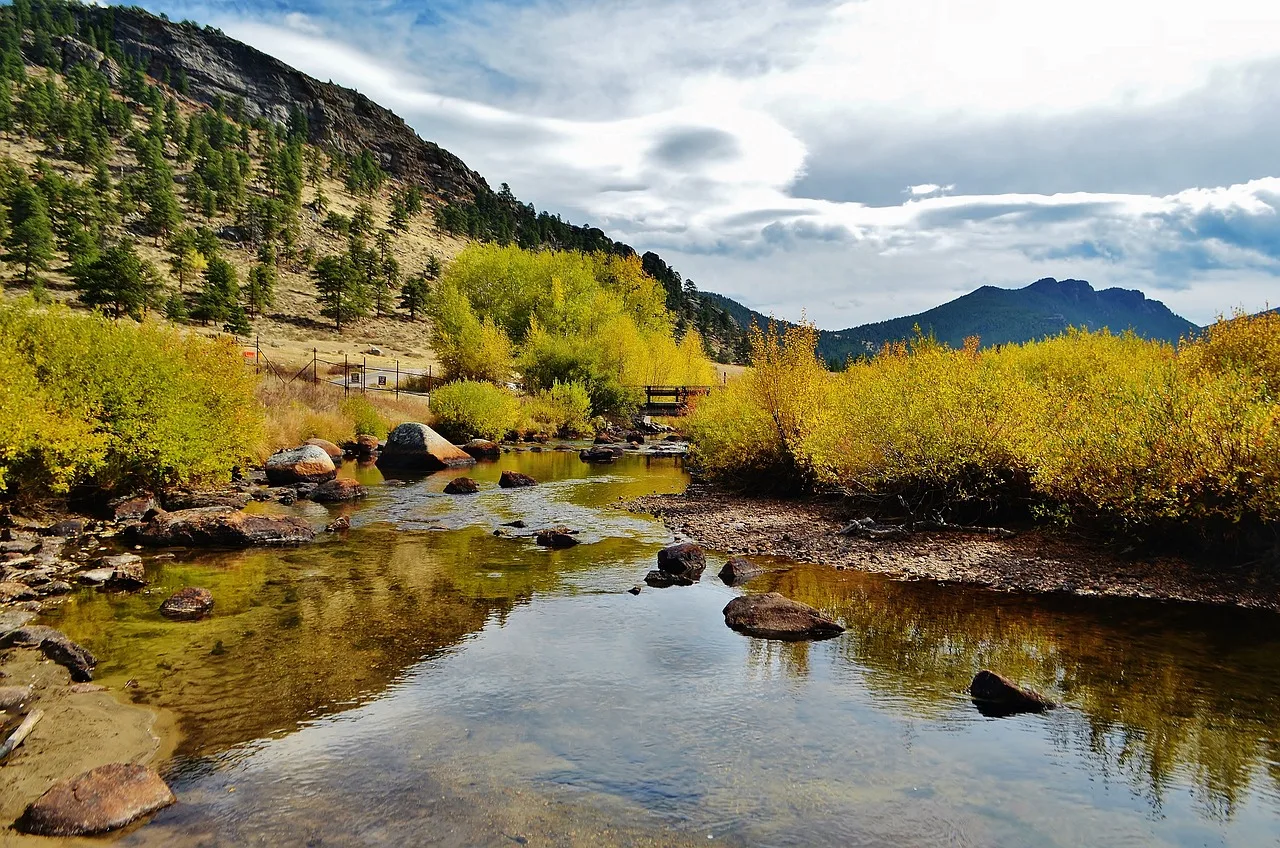Rocky Mountain National Park Travel Guide:
Rocky Mountain National Park is like a nature symphony, with towering peaks, serene forests, and crystal-clear lakes singing in harmony. It sits right on the Continental Divide in Colorado and boasts some of the country’s highest peaks, reaching a breathtaking 14,000 feet. This alpine wonderland isn’t just about high summits; it’s also home to expansive stretches of tundra, shimmering lakes, and streams shaded by aspen trees where you might catch a glimpse of black bears, elk, moose, or bighorn sheep.
Humans have wandered through these lands for millennia. Ancient mammoth hunters first explored here, followed by the Ute and Arapaho people who spent summers in the area until the 1800s. Today, Rocky Mountain National Park showcases the incredible diversity and beauty of the Rocky Mountains. It’s a place of extremes and pure natural beauty, with a variety of trails, accommodation options, and dining spots nearby to cater to every type of traveler.
In our guide, we’ll dive into everything you need to know before you visit Rocky Mountain National Park. From the best times to experience its wonders to the most awe-inspiring mountain hikes that will stay with you long after you’ve left. Visit this park, and you’ll quickly understand why so many people consider it one of the absolute best national parks in the entire United States.
Accessing Rocky Mountain National Park
Getting to Rocky Mountain National Park is relatively straightforward, especially if you’re traveling from major Front Range areas like Denver, Fort Collins, or Denver International Airport. The primary entrance at Beaver Meadows, situated on the park’s east side, is easily reachable via U.S. Highway 36 from the south or Highway 34 from the north or east. For a longer but incredibly scenic route, consider the Peak-to-Peak Scenic Byway. This breathtaking detour offers stunning views of the Continental Divide as it winds through the high elevations west of Boulder.
Alternatively, you can access the quieter west side of the park through the Kawuneeche Entrance using U.S. Highway 34, which is convenient for those arriving from the west. Additionally, lesser-known entrance stations like Wild Basin and Longs Peak grant access to specific locations within the park.

Entry Permits and Regulations
During the peak season, from late May to late October, visitors must secure a timed-entry permit through recreation.gov to access the park during busy daytime hours. Sixty percent of these permits are released in advance, approximately a month before the desired start date, while the remaining 40 percent become available the day before. However, if you’ve made reservations for a campground or an organized trip, a separate permit for park entry isn’t required.
Choosing the Ideal Time for Your Visit
Rocky Mountain National Park experiences its peak season from summer into mid-autumn, drawing crowds for a good reason. July through October showcases a canvas of blooming wildflowers, mostly snow-free trails, the mesmerizing golden hues of aspen foliage, and an abundance of active wildlife. Weather during this period is generally delightful, with warm, sunlit days and cool, refreshing nights, although September might see the start of snowfall, especially in the higher elevations.
Winter and spring, which often resembles an extended winter, have their own charm for visitors interested in snow-centric activities like snowshoeing, cross-country skiing, and backcountry skiing. However, be prepared for cold temperatures, strong winds, and substantial snowfall. Trail Ridge Road, the park’s main route, typically closes between late October and late May due to weather conditions. By May, snow begins to melt in the lower elevations, which sit around 8,000 feet, offering glimpses of wildlife offspring like elk and moose calves grazing on the fresh greenery.
Top Activities in Rocky Mountain National Park
Scenic Drives
Trail Ridge Road takes the spotlight as the park’s 48-mile high-alpine highway, linking Estes Park in the east to Grand Lake in the west. It’s renowned as America’s highest continuous paved road, with an impressive 11 miles soaring above the treeline. The road offers a breathtaking assortment of Rocky Mountain highlights, from lush valleys and dense forests to expansive mountain vistas. Even driving from one endpoint to the Alpine Visitor Center at 11,796 feet promises an unforgettable experience.
Hiking
Exploring Rocky Mountain National Park on foot is essential for soaking in its beauty. With approximately 350 miles of trails, there’s something for every adventurer, ranging from easy strolls to challenging mountaineering routes. For an easier hike, consider the 1.6-mile round trip to Alberta Falls, a striking 30-foot waterfall starting at the Glacier Gorge Trailhead. Another popular option is the trio of Nymph, Dream, and Emerald Lakes. Starting from Bear Lake, the half-mile hike to Nymph Lake offers stunning views of Hallett Peak, with Dream Lake 0.6 miles further and Emerald Lake an additional 1.3 miles beyond that.
For those keen on exploring the tundra, the 12,880-foot Mt. Ida offers incredible panoramic views of remote alpine lakes. The 9.6-mile round trip begins at Milner Pass, climbing a rocky ridge to reach the summit. This hike demands good fitness, basic route finding skills, and a clear weather window.

Longs Peak Summit
Longs Peak, the highest point in Rocky Mountain National Park at 14,259 feet, entices experienced hikers with its coveted summit. The Class-3 Keyhole Route demands a pre-dawn start to avoid afternoon thunderstorms, covering 15 miles and ascending 5,000 feet in elevation. Reserved for fit and seasoned hikers, conquering Longs Peak is considered the park’s ultimate achievement.
Horseback Riding
Saddle up for an unparalleled view of park trails with Hi Country/Glacier Creek Stables, the exclusive in-park horseback riding outfit. They offer two-, three-, and five-hour rides departing from Sprague Lake, priced at $110, $140, and $245 per person, respectively. It’s an opportunity to explore the beauty of Rocky Mountain National Park from a unique perspective.
Fishing
Fly-fishing in the pristine lakes of Rocky Mountain National Park is a lure for anglers seeking trout like brook, brown, rainbow, and cutthroat. Many park waters are open for casting, with some of the finest fishing experiences found in the backcountry lakes. Kirks Flyshop in Estes Park provides gear rentals and various guided trips to enhance your angling adventure.
Snowshoeing in Winter
Winter transforms the park into a wonderland waiting to be explored, and snowshoeing is the perfect way to do it. Strap on a pair of snowshoes and head out to discover trails like the 5.6-mile round trip to Mills Lake, a serene journey amid Glacier Gorge during the quieter months. Additionally, park rangers conduct guided snowshoe treks on both the east and west sides of the park. These guided experiences are free but require reservations, offering a fantastic opportunity to explore the winter wonder of Rocky Mountain National Park.
Accommodation Options
For those seeking to stay within Rocky Mountain National Park, the park itself doesn’t feature in-park lodges. However, you have the choice of five car campgrounds. One recommended option is Aspenglen, a charming 52-site campground nestled in the pine forest close to the Fall River Entrance. It’s priced at $35 per night and requires reservations.
If you’re considering Estes Park as your base, the iconic Stanley Hotel awaits. Renowned as the inspiration for Stephen King’s novel “The Shining,” this elegant hotel has welcomed guests since 1909. Accommodation ranges from historic rooms to modern boutique-style units and even apartments, offering a variety of choices to suit different preferences.
Alternatively, in Grand Lake just outside the park boundary, the rustic Grand Lake Lodge presents a picturesque setting with views of the lake. The lodge offers a range of accommodations including cabins and glamping-style jupe tents, along with amenities like a pool, making it an inviting choice for visitors exploring the area.

Food and Dining Recommendations
Within Rocky Mountain National Park, dining choices are limited to sandwiches and coffee available at the Café at Trail Ridge within the Alpine Visitor Center. Thus, it’s advisable to explore dining options in the nearby gateway towns before or after your day’s adventures.
In Estes Park, you’ll find a variety of dining experiences ranging from steaks, burgers, and oversized burritos to elevated culinary offerings. Bird & Jim stands out, emphasizing locally sourced ingredients, boasting an extensive wine selection, and offering a cocktail menu with a focus on bourbon and whiskey. At the Stanley Hotel, you’ll discover not just one, but three restaurants: Cascades Restaurant & Lounge serves upscale game meat dishes, The Post offers hot chicken and microbrews, while Brunch & Co. caters to those seeking fancy pancake delights.
On the other side of the divide, Grand Lake boasts Sagebrush BBQ & Grill, earning its local-favorite status thanks to an extensive menu featuring ribs, brisket, seafood, and wild-game sausage, making it a noteworthy dining destination in the area.
Read also: https://growbywill.com/blue-lakes-colorado-tour-guide-to-the-hiking-trail/
